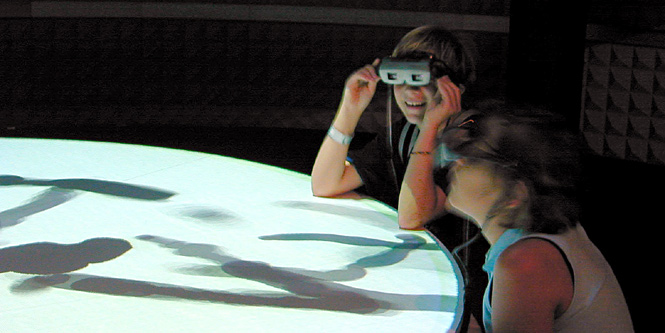Printed from www.flong.com
Contents © 2020 Golan Levin and Collaborators
Golan Levin and Collaborators
Projects
Sort by : Author | Date | Name | Type
- Installations
- Ghost Pole Propagator II
- Augmented Hand Series
- Eyeshine
- Re:FACE, Anchorage Version
- Merce's Isosurface
- Double-Taker (Snout)
- Opto-Isolator
- Eyecode
- Interstitial Fragment Processor
- Reface [Portrait Sequencer]
- Ghost Pole Propagator
- Footfalls
- Scrapple (Installation)
- The Manual Input Workstation
- Interactive Bar Tables
- Messa di Voce (Installation)
- Hidden Worlds of Noise and Voice
- Re:MARK
- Introspection Machine
- Audiovisual Environment Suite
- Dakadaka
- Rouen Revisited
- Performances
- Ursonography
- Scrapple (Performance)
- The Manual Input Sessions
- Messa di Voce (Performance)
- Dialtones (A Telesymphony)
- Scribble
- Net.Artworks
- Terrapattern
- Moon Drawings
- Free Universal Construction Kit
- QR Codes for Digital Nomads
- The Dumpster
- Axis
- JJ (Empathic Network Visualization)
- The Secret Lives of Numbers
- Alphabet Synthesis Machine
- Obzok
- Sketches
- Stria
- Dendron
- Slamps
- Banded Clock
- Floccus
- Stripe
- Meshy
- Directrix
- Yellowtail
- Streamer
- Blebs
- Self-Adherence (for Written Images)
- Poster design for Maeda lecture
- The Role of Relative Velocity
- Segmentation and Symptom
- Floccular Portraits
- Curatorial
- Mobile Art && Code
- ART AND CODE
- Code, Form, Space
- IEEE InfoVis 2008 Art Exhibition
- Solo exhibition at bitforms gallery
- IEEE InfoVis 2007 Art Exhibition
- Signal Operators
- Commercial / Industrial
- Motion Traces [A1 Corridor]
- Civic Exchange Prototype
- Amore Pacific Display
- Interactive Logographs
- Interval Projects
- Media Streams Icons
- Miscellaneous
- NeoLucida
- Rectified Flowers
- GML Experiments
- New Year Cards
- Admitulator
- Glharf (or Glarf)
- Finger Spies
Hidden Worlds of Noise and Voice
2002 | Tmema (Golan Levin & Zachary Lieberman) with Ars Electronica Futurelab

Overview. The Hidden Worlds of Noise and Voice (2002: Golan Levin and Zachary Lieberman with the production of Ars Electronica Futurelab) is an interactive audiovisual installation whose central theme is the magical relationship of speech to the ethereal medium which conveys it. Participants in this exhibit are able to "see" each others' voices, made visible in the form of animated graphic figurations that appear to emerge from the participants' mouths. In the Hidden Worlds installation, users wear special see-through glasses, which register and superimpose 3D graphics into the real world; when one of the users speaks, colorful abstract forms appear to emerge from his or her mouth. The shapes and movements of these forms are tightly coupled to the unique qualities of the timbres and phonemes sung or spoken by the user, thus enabling a wide range of audiovisual play. The graphics constitute a consensual hallucination which is shared by all of the participants.
Hidden Worlds of Noise and Voice by Tmema + AEC from Tmema on Vimeo.
The Hidden Worlds of Noise and Voice is an interactive audiovisual installation, or, alternatively, an augmented-reality speech-visualization system. Its central theme is the magical relationship of speech to the ethereal medium which conveys it. Participants in Hidden Worlds are able to "see" each others' voices, which are made visible in the form of animated graphic figurations that appear to emerge from the participants' mouths while they speak. In the installation, visitors wear special see-through data glasses, which register and superimpose 3D graphics into the real world. When one of the users speaks or sings, colorful abstract forms appear to emerge from his or her mouth. The graphics representing these utterances assume a wide variety of shapes and behaviors that are tightly coupled to the unique qualities of the vocalist's volume, pitch and timbre.
Hidden Worlds permits up to six visitors to participate in the consensual hallucination, enabling a wide range of engaging audiovisual and conversational play. For those who are not equipped with the data-glasses, a projection at the center of the installation makes visible the "shadows" of the virtual spoken forms. Hidden Worlds was developed in the Summer of 2002, and was installed in a two-year exhibition at the Ars Electronica Museum of the Future in Linz, Austria.
Credits
The Hidden Worlds of Noise and Voice was a commission of the Ars Electronica Museum of the Future. It was made possible within the framework of the Ars Electronica Futurelab's Artist-In-Residence Program, generously sponsored by Siemens. Additional funding for the Hidden Worlds installation was generously provided by SAP.
Gerfried Stocker: curation, exhibition concept
Golan Levin: art, design, software engineering
Zachary Lieberman: art, design, software engineering
Scott Ritter: architecture and interior design
Peter Htmansberger: Linux administration
Ars Electronica Futurelab team:
Robert Abt: signal analysis software
Michael Breidenbruecker: additional concept
Peter Freundling: HMD industrial design
Yvonne Hauser: general administration
Horst Hrtner: executive management
Gerold Hofstadler: technical administration
Martin Honzik: system administration
Christopher Lindinger: video software engineering
Stefan Mittlbck-Jungwirth: HMD & optics hardware
Dietmar Offenhuber: project management
Robert Praxmarer: VGA driver engineering
Nina Wenhart: video documentation
Wolfgang Ziegler: head-tracking software
Additional Resources
High-resolution photos of The Hidden Worlds of Noise and Voice are available in this Tmema photoset on Flickr.